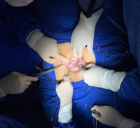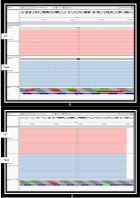Abstract
Retrospective Study
Does change in cervical dilation after anesthesia impact latency after cerclage placement?
Michelle N Lende*, Paul J Feustel, Erica K Nicasio and Tara A Lynch
Published: 24 April, 2023 | Volume 6 - Issue 2 | Pages: 028-031
Background: Pregnant individuals with early cervical dilation have a high risk for preterm birth. The authors encountered cases where cervical dilation increased after anesthesia administration for a cerclage.
Objective: The primary objective was to assess if a change in cervical dilation after anesthesia administration for a cerclage was associated with a shorter latency to delivery.
Study design: This was a retrospective chart review of pregnancies from January 1, 2011, to December 31, 2021, who had a cerclage and delivered at our institution. Maternal demographics, obstetrical history, operative details, and delivery information were collected. Multi-fetal gestations, un-indicated cerclages, and abdominal cerclages were excluded. The primary outcome was the difference in cervical dilation between the office and the operating room after spinal anesthesia administration. A multivariable regression was performed.
Results: A total of 183 pregnancies were included. The mean gestational age at cerclage placement was 18 weeks (STDEV 3.6). Twenty-nine percent of patients (53/183) were more dilated in the operating room compared to the office The latency between cerclage and delivery was not different if there was a cervical change between these settings (p = 0.655). There was an increased risk for preterm delivery with dilation in the office (OR 1.01, CI 1.01 to 2.5), but not with dilation in the operating room (OR 1.4, CI 0.9 to 2.0).
Conclusion: Cervical dilation between the office and the operating room is different. Pregnancies with more dilation delivered at earlier gestations. However, a change in dilation between the office and the operating room was not associated with a shorter latency.
Read Full Article HTML DOI: 10.29328/journal.cjog.1001125 Cite this Article Read Full Article PDF
Keywords:
Preterm; Cervical dilation; Cerclage; Gestational age; Physical exam indicated; An ultrasound indicated; History indicated
References
- American College of Obstetricians and Gynecologists' Committee on Practice Bulletins—Obstetrics. Prediction and Prevention of Spontaneous Preterm Birth: ACOG Practice Bulletin, Number 234. Obstet Gynecol. 2021 Aug 1;138(2):e65-e90. doi: 10.1097/AOG.0000000000004479. PMID: 34293771.
- American College of Obstetricians and Gynecologists’ Committee on Practice Bulletins—Obstetrics. Practice Bulletin No. 171: Management of Preterm Labor. Obstet Gynecol. 2016 Oct;128(4):e155-64. doi: 10.1097/AOG.0000000000001711. PMID: 27661654.
- ACOG Practice Bulletin No.142: Cerclage for the management of cervical insufficiency. Obstet Gynecol. 2014 Feb;123(2 Pt 1):372-379. doi: 10.1097/01.AOG.0000443276.68274.cc. PMID: 24451674.
- Ehsanipoor RM, Seligman NS, Saccone G, Szymanski LM, Wissinger C, Werner EF, Berghella V. Physical Examination-Indicated Cerclage: A Systematic Review and Meta-analysis. Obstet Gynecol. 2015 Jul;126(1):125-35. doi: 10.1097/AOG.0000000000000850. PMID: 26241265.
- Conde-Agudelo A, Romero R, Da Fonseca E, O'Brien JM, Cetingoz E, Creasy GW, Hassan SS, Erez O, Pacora P, Nicolaides KH. Vaginal progesterone is as effective as cervical cerclage to prevent preterm birth in women with a singleton gestation, previous spontaneous preterm birth, and a short cervix: updated indirect comparison meta-analysis. Am J Obstet Gynecol. 2018 Jul;219(1):10-25. doi: 10.1016/j.ajog.2018.03.028. Epub 2018 Apr 7. PMID: 29630885; PMCID: PMC6449041.
- Sanchez-Ramos L. Vaginal progesterone is an alternative to cervical cerclage in women with a short cervix and a history of preterm birth. Am J Obstet Gynecol. 2018 Jul;219(1):5-9. doi: 10.1016/j.ajog.2018.05.010. PMID: 29941278.
- Leveno KJ, Cox K, Roark ML. Cervical dilatation and prematurity revisited. Obstet Gynecol. 1986 Sep;68(3):434-5. doi: 10.1097/00006250-198609000-00031. PMID: 3737067.
- Miller ES, Grobman WA, Fonseca L, Robinson BK. Indomethacin and antibiotics in examination-indicated cerclage: a randomized controlled trial. Obstet Gynecol. 2014 Jun;123(6):1311-1316. doi: 10.1097/AOG.0000000000000228. PMID: 24807330.
- How HY, Khoury JC, Sibai BM. Cervical dilatation on presentation for preterm labor and subsequent preterm birth. Am J Perinatol. 2009 Jan;26(1):1-6. doi: 10.1055/s-0028-1090586. Epub 2008 Nov 19. PMID: 19021099.
- Phelps JY, Higby K, Smyth MH, Ward JA, Arredondo F, Mayer AR. Accuracy and intraobserver variability of simulated cervical dilatation measurements. Am J Obstet Gynecol. 1995 Sep;173(3 Pt 1):942-5. doi: 10.1016/0002-9378(95)90371-2. PMID: 7573274.
- Buchmann EJ, Libhaber E. Accuracy of cervical assessment in the active phase of labour. BJOG. 2007 Jul;114(7):833-7. doi: 10.1111/j.1471-0528.2007.01386.x. PMID: 17567418.
Figures:
Similar Articles
-
Screening of Gestational diabetes mellitusGehan Farid*,Sarah Rabie Ali*,Reem Mohammed Kamal. Screening of Gestational diabetes mellitus . . 2018 doi: 10.29328/journal.cjog.1001003; 1: 014-023
-
The Case of the Phantom Trophoblastic TumorBenedict B Benigno*. The Case of the Phantom Trophoblastic Tumor. . 2018 doi: 10.29328/journal.cjog.1001004; 1: 024-025
-
Maternal and fetal outcome of comparative study between old & adopted new value of screening of Gestational Diabetes Mellitus in tertiary centre in Saudi ArabiaGehan Farid*,Reem Mohammed Kamal*,Mohamed AH Swaraldahab,Sarah Rabie Ali. Maternal and fetal outcome of comparative study between old & adopted new value of screening of Gestational Diabetes Mellitus in tertiary centre in Saudi Arabia. . 2018 doi: 10.29328/journal.cjog.1001005; 1: 026-034
-
Trans-abdominal cervical cerclage revisitedJohn Svigos*. Trans-abdominal cervical cerclage revisited. . 2019 doi: 10.29328/journal.cjog.1001019; 2: 017-024
-
Intracerebral Hemorrhage of Brainstem in triple pregnancy after in vitro fertilization by receiving Ovum Donation: A case report and reviewAndreas Suhartoyo Winarno*,Lukas Schloesser,Frederic Dietzel,Percy Balan,Thomas Hoehn,Monika Hampl,Tanja Natascha Fehm. Intracerebral Hemorrhage of Brainstem in triple pregnancy after in vitro fertilization by receiving Ovum Donation: A case report and review. . 2019 doi: 10.29328/journal.cjog.1001037; 2: 138-144
-
Oral Clindamycin and Metronidazole in the treatment of bacterial vaginosis in pregnant black women: Comparison of efficacy and pregnancy outcomeIjeoma CC*,Nyengidiki TK,Bassey G,Ogu RN,Alegbeleye JO,Wariso KT. Oral Clindamycin and Metronidazole in the treatment of bacterial vaginosis in pregnant black women: Comparison of efficacy and pregnancy outcome. . 2020 doi: 10.29328/journal.cjog.1001040; 3: 001-006
-
Trial of labor after cesarean outcomes with excessive gestational weight gainSophia Halassy*,Angela Marras. Trial of labor after cesarean outcomes with excessive gestational weight gain. . 2020 doi: 10.29328/journal.cjog.1001048; 3: 039-042
-
Determinants of neonatal near miss among neonates admitted to Ambo University Referral Hospital and Ambo General Hospital, Ethiopia, 2019Ephrem Yohannes*,Nega Assefa,Yadeta Dessie. Determinants of neonatal near miss among neonates admitted to Ambo University Referral Hospital and Ambo General Hospital, Ethiopia, 2019. . 2020 doi: 10.29328/journal.cjog.1001050; 3: 046-053
-
COVID-19 in pregnancy: Our experience at a tertiary maternity unit in FranceDarido Jessie*,El Haddad Cynthia,Diari Jed,Grevoul Fesquet Julie,Bouzid Nassima,Bobric Andrea,Lakhdara Nefissa,Bazzi Zeinab,Lebis Cindy,Khadam Louay,Rigonnot Luc. COVID-19 in pregnancy: Our experience at a tertiary maternity unit in France. . 2020 doi: 10.29328/journal.cjog.1001051; 3: 054-064
-
Hemorrhagic shock due to irreducible uterine torsion in a third trimester twin pregnancy: A case reportDarido J*,Grevoul Fesquet J,Diari J,El Haddad C,Bouzid N,Abou El Hassan N,Khadam L,Rigonnot L. Hemorrhagic shock due to irreducible uterine torsion in a third trimester twin pregnancy: A case report. . 2020 doi: 10.29328/journal.cjog.1001055; 3: 085-089
Recently Viewed
-
A Low-cost High-throughput Targeted Sequencing for the Accurate Detection of Respiratory Tract PathogenChangyan Ju, Chengbosen Zhou, Zhezhi Deng, Jingwei Gao, Weizhao Jiang, Hanbing Zeng, Haiwei Huang, Yongxiang Duan, David X Deng*. A Low-cost High-throughput Targeted Sequencing for the Accurate Detection of Respiratory Tract Pathogen. Int J Clin Virol. 2024: doi: 10.29328/journal.ijcv.1001056; 8: 001-007
-
A Comparative Study of Metoprolol and Amlodipine on Mortality, Disability and Complication in Acute StrokeJayantee Kalita*,Dhiraj Kumar,Nagendra B Gutti,Sandeep K Gupta,Anadi Mishra,Vivek Singh. A Comparative Study of Metoprolol and Amlodipine on Mortality, Disability and Complication in Acute Stroke. J Neurosci Neurol Disord. 2025: doi: 10.29328/journal.jnnd.1001108; 9: 039-045
-
Development of qualitative GC MS method for simultaneous identification of PM-CCM a modified illicit drugs preparation and its modern-day application in drug-facilitated crimesBhagat Singh*,Satish R Nailkar,Chetansen A Bhadkambekar,Suneel Prajapati,Sukhminder Kaur. Development of qualitative GC MS method for simultaneous identification of PM-CCM a modified illicit drugs preparation and its modern-day application in drug-facilitated crimes. J Forensic Sci Res. 2023: doi: 10.29328/journal.jfsr.1001043; 7: 004-010
-
A Gateway to Metal Resistance: Bacterial Response to Heavy Metal Toxicity in the Biological EnvironmentLoai Aljerf*,Nuha AlMasri. A Gateway to Metal Resistance: Bacterial Response to Heavy Metal Toxicity in the Biological Environment. Ann Adv Chem. 2018: doi: 10.29328/journal.aac.1001012; 2: 032-044
-
Obesity in Patients with Chronic Obstructive Pulmonary Disease as a Separate Clinical PhenotypeDaria A Prokonich*, Tatiana V Saprina, Ekaterina B Bukreeva. Obesity in Patients with Chronic Obstructive Pulmonary Disease as a Separate Clinical Phenotype. J Pulmonol Respir Res. 2024: doi: 10.29328/journal.jprr.1001060; 8: 053-055
Most Viewed
-
Evaluation of Biostimulants Based on Recovered Protein Hydrolysates from Animal By-products as Plant Growth EnhancersH Pérez-Aguilar*, M Lacruz-Asaro, F Arán-Ais. Evaluation of Biostimulants Based on Recovered Protein Hydrolysates from Animal By-products as Plant Growth Enhancers. J Plant Sci Phytopathol. 2023 doi: 10.29328/journal.jpsp.1001104; 7: 042-047
-
Sinonasal Myxoma Extending into the Orbit in a 4-Year Old: A Case PresentationJulian A Purrinos*, Ramzi Younis. Sinonasal Myxoma Extending into the Orbit in a 4-Year Old: A Case Presentation. Arch Case Rep. 2024 doi: 10.29328/journal.acr.1001099; 8: 075-077
-
Feasibility study of magnetic sensing for detecting single-neuron action potentialsDenis Tonini,Kai Wu,Renata Saha,Jian-Ping Wang*. Feasibility study of magnetic sensing for detecting single-neuron action potentials. Ann Biomed Sci Eng. 2022 doi: 10.29328/journal.abse.1001018; 6: 019-029
-
Pediatric Dysgerminoma: Unveiling a Rare Ovarian TumorFaten Limaiem*, Khalil Saffar, Ahmed Halouani. Pediatric Dysgerminoma: Unveiling a Rare Ovarian Tumor. Arch Case Rep. 2024 doi: 10.29328/journal.acr.1001087; 8: 010-013
-
Physical activity can change the physiological and psychological circumstances during COVID-19 pandemic: A narrative reviewKhashayar Maroufi*. Physical activity can change the physiological and psychological circumstances during COVID-19 pandemic: A narrative review. J Sports Med Ther. 2021 doi: 10.29328/journal.jsmt.1001051; 6: 001-007

HSPI: We're glad you're here. Please click "create a new Query" if you are a new visitor to our website and need further information from us.
If you are already a member of our network and need to keep track of any developments regarding a question you have already submitted, click "take me to my Query."



















































































































































